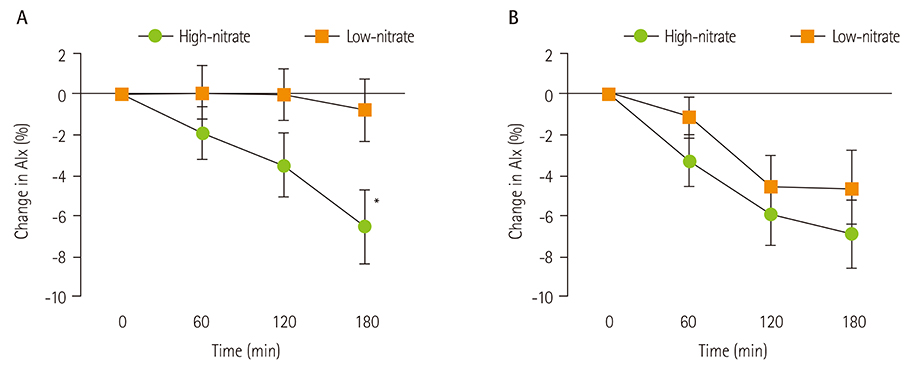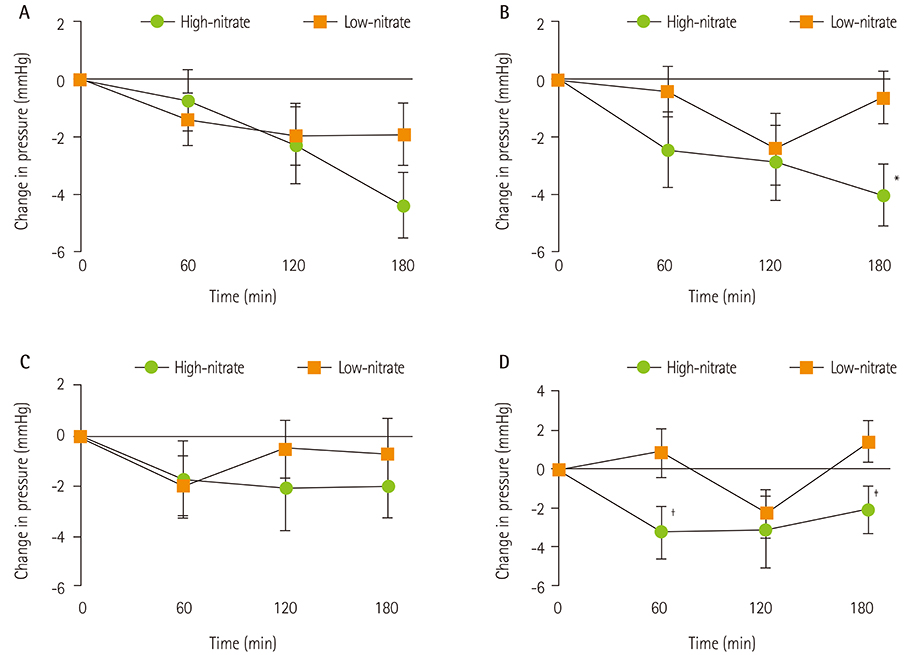Clin Nutr Res.
2015 Jul;4(3):160-167. 10.7762/cnr.2015.4.3.160.
Effect of Spinach, a High Dietary Nitrate Source, on Arterial Stiffness and Related Hemodynamic Measures: A Randomized, Controlled Trial in Healthy Adults
- Affiliations
-
- 1Clinical Nutrition and Risk Factor Modification Centre, St. Michael's Hospital, Toronto, ON M5B 1W8, Canada. v.vuksan@utoronto.ca
- 2Department of Nutritional Sciences, Faculty of Medicine, University of Toronto, Toronto, ON M5S 1A8, Canada.
- 3Keenan Research Centre of the Li Ka Shing Knowledge Institute, St. Michael's Hospital, Toronto, ON M5B 1W8, Canada.
- 4Department of Medicine, Faculty of Medicine, University of Toronto, Toronto, ON M5S 1A8, Canada.
- 5Division of Endocrinology & Metabolism, St. Michael's Hospital, Toronto, ON M5B 1W8, Canada.
- KMID: 2148625
- DOI: http://doi.org/10.7762/cnr.2015.4.3.160
Abstract
- Diets rich in fruits and vegetables reduce risk of adverse cardiovascular events. However, the constituents responsible for this effect have not been well established. Lately, the attention has been brought to vegetables with high nitrate content with evidence that this might represent a source of vasoprotective nitric oxide. We hypothesized that short-term consumption of spinach, a vegetable having high dietary nitrate content, can affect the arterial waveform indicative of arterial stiffness, as well as central and peripheral blood pressure (BP). Using a placebo-controlled, crossover design, 27 healthy participants were randomly assigned to receive either a high-nitrate (spinach; 845 mg nitrate/day) or low-nitrate soup (asparagus; 0.6 mg nitrate/day) for 7 days with a 1-week washout period. On days 1 and 7, profiles of augmentation index, central, and brachial BP were obtained over 180 min post-consumption in 4 fasted visits. A postprandial reduction in augmentation index was observed at 180 min on high-nitrate compared to low-nitrate intervention (-6.54 +/- 9.7% vs. -0.82 +/- 8.0%, p = 0.01) on Day 1, and from baseline on Day 7 (-6.93 +/- 8.7%, p < 0.001; high vs. low: -2.28 +/- 12.5%, p = 0.35), suggesting that the nitrate intervention is not associated with the development of tolerance for at least 7 days of continued supplementation. High vs. low-nitrate intervention also reduced central systolic (-3.39 +/- 5.6 mmHg, p = 0.004) and diastolic BP (-2.60 +/- 5.8 mmHg, p = 0.028) and brachial systolic BP (-3.48 +/- 7.4 mmHg, p = 0.022) at 180 min following 7-day supplementation only. These findings suggest that dietary nitrate from spinach may contribute to beneficial hemodynamic effects of vegetable-rich diets and highlights the potential of developing a targeted dietary approach in the management of elevated BP.
Keyword
MeSH Terms
Figure
Reference
-
1. World Heart Federation (CH). Hypertension [Internet]. Geneva: World Heart Federation;2012. cited 2014 September 6. Available from: http://www.world-heart-federation.org/cardiovascular-health/cardiovascular-disease-risk-factors/hypertension/.2. National Heart Lung and Blood Institute (US). How is high blood pressure treated? [Internet]. Bethesda (MD): National Heart Lung and Blood Institute;2012. cited 2014 September 6. Available from: http://www.nhlbi.nih.gov/health/healthtopics/topics/hbp/treatment.3. Appel LJ, Moore TJ, Obarzanek E, Vollmer WM, Svetkey LP, Sacks FM, Bray GA, Vogt TM, Cutler JA, Windhauser MM, Lin PH, Karanja N. DASH Collaborative Research Group. A clinical trial of the effects of dietary patterns on blood pressure. N Engl J Med. 1997; 336:1117–1124.
Article4. Hord NG, Tang Y, Bryan NS. Food sources of nitrates and nitrites: the physiologic context for potential health benefits. Am J Clin Nutr. 2009; 90:1–10.
Article5. Laurent S, Boutouyrie P, Asmar R, Gautier I, Laloux B, Guize L, Ducimetiere P, Benetos A. Aortic stiffness is an independent predictor of all-cause and cardiovascular mortality in hypertensive patients. Hypertension. 2001; 37:1236–1241.
Article6. Rammos C, Hendgen-Cotta UB, Sobierajski J, Bernard A, Kelm M, Rassaf T. Dietary nitrate reverses vascular dysfunction in older adults with moderately increased cardiovascular risk. J Am Coll Cardiol. 2014; 63:1584–1585.
Article7. Jajja A, Sutyarjoko A, Lara J, Rennie K, Brandt K, Qadir O, Siervo M. Beetroot supplementation lowers daily systolic blood pressure in older, overweight subjects. Nutr Res. 2014; 34:868–875.
Article8. Agabiti-Rosei E, Mancia G, O'Rourke MF, Roman MJ, Safar ME, Smulyan H, Wang JG, Wilkinson IB, Williams B, Vlachopoulos C. Central blood pressure measurements and antihypertensive therapy: a consensus document. Hypertension. 2007; 50:154–160.
Article9. Chobanian AV, Bakris GL, Black HR, Cushman WC, Green LA, Izzo JL Jr, Jones DW, Materson BJ, Oparil S, Wright JT Jr, Roccella EJ. Joint National Committee on Prevention, Detection, Evaluation, and Treatment of High Blood Pressure. National Heart, Lung, and Blood Institute. National High Blood Pressure Education Program Coordinating Committee. Seventh report of the Joint National Committee on Prevention, Detection, Evaluation, and Treatment of High Blood Pressure. Hypertension. 2003; 42:1206–1252.
Article10. Dhindsa M, Barnes JN, DeVan AE, Sugawara J, Tanaka H. Comparison of augmentation index derived from multiple devices. Artery Res. 2011; 5:112–114.
Article11. Sobko T, Marcus C, Govoni M, Kamiya S. Dietary nitrate in Japanese traditional foods lowers diastolic blood pressure in healthy volunteers. Nitric Oxide. 2010; 22:136–140.
Article12. Bailey SJ, Winyard P, Vanhatalo A, Blackwell JR, Dimenna FJ, Wilkerson DP, Tarr J, Benjamin N, Jones AM. Dietary nitrate supplementation reduces the O2 cost of low-intensity exercise and enhances tolerance to high-intensity exercise in humans. J Appl Physiol (1985). 2009; 107:1144–1155.
Article13. Larsen FJ, Ekblom B, Sahlin K, Lundberg JO, Weitzberg E. Effects of dietary nitrate on blood pressure in healthy volunteers. N Engl J Med. 2006; 355:2792–2793.
Article14. Liu AH, Bondonno CP, Croft KD, Puddey IB, Woodman RJ, Rich L, Ward NC, Vita JA, Hodgson JM. Effects of a nitrate-rich meal on arterial stiffness and blood pressure in healthy volunteers. Nitric Oxide. 2013; 35:123–130.
Article15. Machha A, Schechter AN. Dietary nitrite and nitrate: a review of potential mechanisms of cardiovascular benefits. Eur J Nutr. 2011; 50:293–303.
Article16. Machha A, Schechter AN. Inorganic nitrate: a major player in the cardiovascular health benefits of vegetables? Nutr Rev. 2012; 70:367–372.
Article17. Kapil V, Milsom AB, Okorie M, Maleki-Toyserkani S, Akram F, Rehman F, Arghandawi S, Pearl V, Benjamin N, Loukogeorgakis S, Macallister R, Hobbs AJ, Webb AJ, Ahluwalia A. Inorganic nitrate supplementation lowers blood pressure in humans: role for nitrite-derived NO. Hypertension. 2010; 56:274–281.
Article18. Webb AJ, Patel N, Loukogeorgakis S, Okorie M, Aboud Z, Misra S, Rashid R, Miall P, Deanfield J, Benjamin N, MacAllister R, Hobbs AJ, Ahluwalia A. Acute blood pressure lowering, vasoprotective, and antiplatelet properties of dietary nitrate via bioconversion to nitrite. Hypertension. 2008; 51:784–790.
Article19. Govoni M, Jansson EA, Weitzberg E, Lundberg JO. The increase in plasma nitrite after a dietary nitrate load is markedly attenuated by an antibacterial mouthwash. Nitric Oxide. 2008; 19:333–337.
Article20. Shao Y, Chin CK, Ho CT, Ma W, Garrison SA, Huang MT. Anti-tumor activity of the crude saponins obtained from asparagus. Cancer Lett. 1996; 104:31–36.
Article21. Dartsch PC. Effect of Asparagus-P on cell metabolism of cultured kidney and inflammation-mediating cells. Phytother Res. 2008; 22:1477–1481.
Article22. Fang YL. Purification and monosaccharide composition of saponin from Asparagus officianlis L. Sheng Wu Gong Cheng Xue Bao. 2005; 21:446–450.23. Negi JS, Singh P, Joshi GP, Rawat MS, Bisht VK. Chemical constituents of Asparagus. Pharmacogn Rev. 2010; 4:215–220.
Article24. Jovanovski E, Jenkins A, Dias AG, Peeva V, Sievenpiper J, Arnason JT, Rahelic D, Josse RG, Vuksan V. Effects of Korean red ginseng (Panax ginseng C.A. Mayer) and its isolated ginsenosides and polysaccharides on arterial stiffness in healthy individuals. Am J Hypertens. 2010; 23:469–472.
Article25. Vlachopoulos C, Aznaouridis K, Stefanadis C. Prediction of cardiovascular events and all-cause mortality with arterial stiffness: a systematic review and meta-analysis. J Am Coll Cardiol. 2010; 55:1318–1327.
Article26. Health Canada. Guidelines for Canadian drinking water quality: guideline technical document - nitrate and nitrite [Internet]. Ottawa: Health Canada;2013. cited 2014 September 8. Available from: http://www.hc-sc.gc.ca/ewh-semt/pubs/watereau/nitrate_nitrite/index-eng.php.27. Evaluation of certain food additives and contaminants. World Health Organ Tech Rep Ser. 1995; 859:1–54.28. van Velzen AG, Sips AJ, Schothorst RC, Lambers AC, Meulenbelt J. The oral bioavailability of nitrate from nitrate-rich vegetables in humans. Toxicol Lett. 2008; 181:177–181.
Article
- Full Text Links
- Actions
-
Cited
- CITED
-
- Close
- Share
- Similar articles
-
- Effects of Isometric Handgrip Exercise on Carotid Arterial Function and Cardiovascular Vasoreactivity Response to Sympathetic Stress in Young Adults
- Arterial stiffness and hypertension
- Remote Ischemic Preconditioning Does Not Attenuate Arterial Stiffening Following Acute High-Intensity Resistance Exercise
- Arterial stiffness and hypertension
- Association between physical activity measured using an accelerometer and arterial stiffness based on pulse wave velocity and ankle-brachial index in healthy adults



